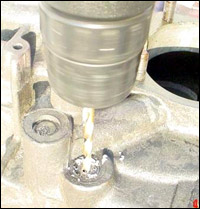
06 May Tapping Oil Galleries
 Once all of the machining for your new performance VW motor is complete and you have mocked up the rotating assembly, its time to wash and assemble. But wait, you may think it is clean after you give it that good spray at the local car wash, but it’s not! You must have access to the main oil galley to properly clean the internal passages of loose debris or machining chips. To do this, you need to remove and replace the stock/ factory pressed in plugs with threaded plugs. This way, you can thoroughly clean your oil galleys and reseal them. Follow along as we demonstrate how to remove the plugs and tap the galley for new plugs.
Once all of the machining for your new performance VW motor is complete and you have mocked up the rotating assembly, its time to wash and assemble. But wait, you may think it is clean after you give it that good spray at the local car wash, but it’s not! You must have access to the main oil galley to properly clean the internal passages of loose debris or machining chips. To do this, you need to remove and replace the stock/ factory pressed in plugs with threaded plugs. This way, you can thoroughly clean your oil galleys and reseal them. Follow along as we demonstrate how to remove the plugs and tap the galley for new plugs.
Here is a list of the tools you will need:
* Slide hammer
* Center marking punch
* Large flat screwdriver
* Oil plunger removing tool
* Small hammer (to remove the oil plunger)
* 3/8″ ratchet and a 16mm, 12-point socket or the correct socket for the tap
* 3/8″ NPT bottoming tap.
* Drill
* 9/16″ drill bit
* A starter drill bit for your slide hammer (The extra wrench is for my slide hammer, because the handle was stripped out to screw it in.)
The first step – and this is really important – is to remove the old oil plungers. The large screw sometimes comes out quickly and easily, but if it is stubborn, then grab the small hammer. Give it a tap on the edge in a counter-clockwise direction (that’s why all the used ones look so beat up).
If your plunger is stuck you may need a puller to remove it.
Use a center punch and drill a “starter hole” for your slide hammer. Don’t drill it too big, as it only needs to be big enough for the threads to grab onto. If you had left the plunger in, you would have just drilled into it and screwed it all up. It becomes very hard to remove after this!
Screw in the slide hammer at least a ¼”, ensuring that it gets a good grab (look at the next picture for depth). Start slide hammering.
You can see how far the slide hammer needs to screw in.
Use the drill and a 9/16″ bit. Notice the milk crate under the case; it helps hold the case, ensuring that it does not turn as you drill. Do not drill too deeply – approximately a 1/2″ – and keep checking, as the magnesium case is easy to drill into.
Tap it with the 3/8″ NPT tap. You may want to keep checking with your plug for depth.
I did not have a bottoming tap so off to the grinder. I took off about a ¼” and re-shaped it to its original starting shape end.
For the back of the case, you will have to take the same steps. Just pay special attention to the depth of the plug, as the rear cam bearing oiling hole and plunger hole are closer than on the front.
Now this is the final result and approximately how deep you will want it. It looks good and will help with the cleaning of your new or old case.To reseal the new plugs, use some removable Loctite. I do not recommend Plumber’s tape or Teflon tape, as this will give you a false impression of how much torque is applied to each plug.





















